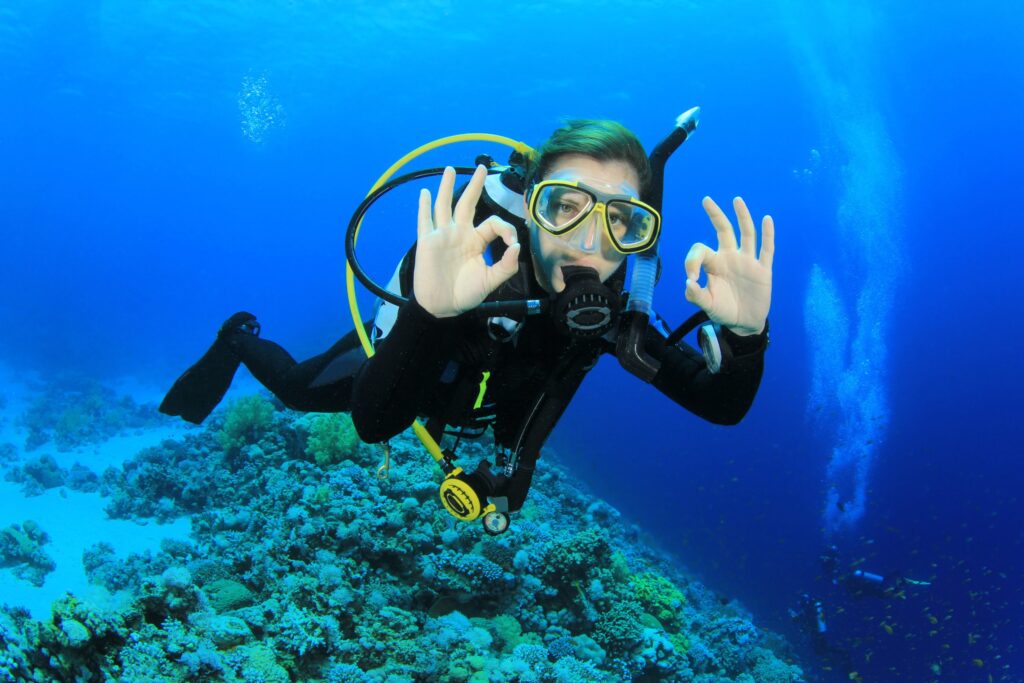Scuba diving is the act of swimming underwater using scuba gear or scuba apparatus to breathe underwater. This scuba apparatus is used to supply a scuba diver with an oxygen supply to breathe underwater. This oxygen is stored in scuba tanks which are just oxygen tanks filled with a mixture of compressed air and oxygen called nitrox; therefore they operate independently of surface oxygen. A scuba diver is an individual using the scuba apparatus to scuba dive.
The nitrox reduces the intake of nitrogen during prolonged or repetitive dives. You can also use gas diluted in helium to reduce nitrogen narcosis.
Scuba diving aims to observe the diverse marine life under our oceans either for study or for pleasure. It can be done in shallow reefs and corals or the deep open blue waters of our oceans.
The term scuba is an abbreviation for self-contained underwater breathing apparatus. It was first invented, patented, and used by Christian J Lambertsen in the year 1952.
There are various types of scuba systems in existence, namely:
- Open circuit scuba system
- Semi-closed and closed-circuit scuba system
In an open circuit scuba system, the gases exhaled by a scuba diver are released into the environment. The open-circuit scuba system is made up of one or more scuba diving cylinders containing nitrox compressed at high pressure. The nitrox is accessed or delivered to the scuba diver using a diving regulator. The number of cylinders containing the nitrox may vary depending on the depth or time the diver plans on staying underwater.
In the semi-closed or closed circuit scuba system, little to no exhaled gasses are released into the environment. This is because this scuba system allows the recycling of exhaled air. In this scuba system, smaller cylinders containing the nitrox are used instead of the bigger ones used in the open circuit scuba system but will last for the same duration as the open circuit.
The semi-closed or closed circuit scuba systems are preferred by military special operators for they produce little to no bubbles which are essential when operating behind enemy lines in the ocean, also preferred by scientists for they do not disturb the marine life they may be studying, and also preferred by media divers for it does not produce bubbles which may interfere with the quality of picture or video.
Armed with the above information, allow me to introduce you to komodo diving by Ayana Komodo resort in Labuan Bajo in Indonesia.
This resort is a perfect retreat destination whose experience will leave you with long-lasting memories for its luxurious state-of-the-art facilities and services encircled by unimaginable natural beauty.
Komodo diving is the realization of a dream for many who have been there to experience it. There are great varieties of marine life, beautiful and untouched coral reefs, and open water fish at every dive site available that are guaranteed to make every dive memorable.
When scuba diving in the Komodo islands, you will be able to see plenty of whitetip and blacktip reef sharks and if you are in luck, you might even see the bigger grey sharks as well as the hammerhead shark. Komodo diving is a fantastic destination. You can book in advance using the Komodo liveaboard website and they are among the best in the world. In addition, they also offer or rather have the lowest rates of any other resort when it comes to scuba diving. They usually charge thirty dollars or twenty Euros per dive per head.
When komodo diving with professional komodo scuba divers, you might be able to view, photograph, or even swim with the peaceful manta ray. They can be spotted all year round but the best time to see them in big numbers is during the rainy season which begins in the month of December and ends in February.
The best diving conditions are in the months of March, April, May, June, July, August, September, and October. You are however advised to enquire with the diving clubs available for not all of them go scuba diving during the rainy season. Also, not much diving is done between January and March because the sea is usually rough.
Komodo diving is however advised to be conducted and undertaken by experienced divers for the currents may be strong in some dive areas, reaching eight knots. These currents are caused by the komodo and Rinca islands which act as a bottleneck between the Indian and the Pacific oceans.
Not all diving spots experience such strong currents. Several other diving spots are calmer but if you want to see the big fish, the areas with the strong currents are the best spots. Therefore if you are a bit inexperienced in diving, consult with your diving guide on the best spot to dive.
Therefore, if your diving guide decides to cancel a dive trip due to safety concerns, do not argue with them for it is for your safety.
Conclusion
If you are a scuba diving enthusiast and want to experience the best scuba diving has to offer, look no further than komodo diving by Ayana resort in Indonesia.
